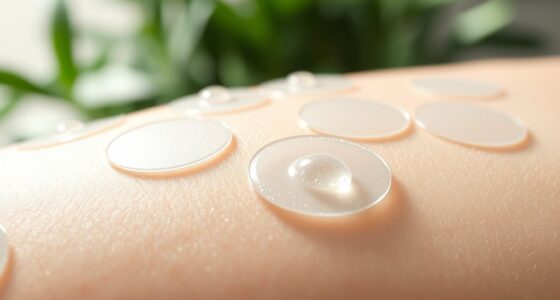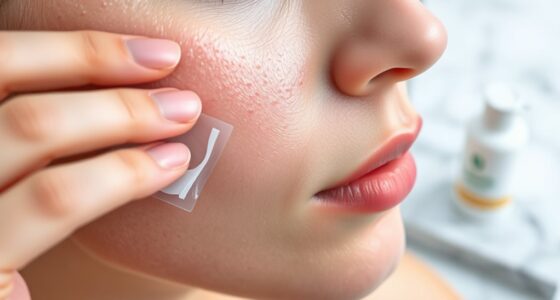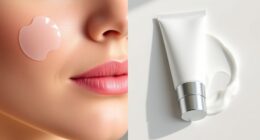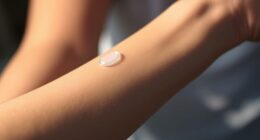You can’t do your full skincare routine with a pimple patch on. Make sure your skin is clean and dry before applying the patch, and avoid using other products like moisturizers or treatments on the area, as they can reduce adhesion and effectiveness. It’s best to apply the patch after cleansing and wait until it’s removed to care for your skin fully. Keep exploring for more tips on how to integrate patches into your routine.
Key Takeaways
- Avoid applying other skincare products directly on the area with the pimple patch to prevent irritation and ensure optimal adhesion.
- Cleanse your skin thoroughly before applying the patch, ensuring it is dry for better effectiveness.
- Do not use strong acne treatments underneath the patch, as they may cause irritation or reduce the patch’s effectiveness.
- After removing the patch, apply a gentle moisturizer and soothing toner to hydrate and calm the skin.
- Monitor skin reactions and consult a dermatologist if you experience persistent irritation or discomfort while using patches.
Understanding Pimple Patches and Their Purpose

When you’re dealing with breakouts, understanding pimple patches and their purpose can make a significant difference in your skincare routine.
These patches typically contain hydrocolloid material that absorbs excess oil and dirt, creating a protective barrier over your pimple. Some patches include salicylic acid or tea tree oil, which help reduce inflammation and bacteria. Additionally, pimple patches can create a protective barrier that reduces the temptation to pick or squeeze blemishes, preventing irritation and scarring.
Pimple patches use hydrocolloid material to absorb oil and dirt while protecting blemishes, with some featuring salicylic acid or tea tree oil for added benefits.
You might also find microneedling patches that deliver active ingredients deeper into the skin, ideal for cystic acne. By maintaining a moist environment, pimple patches accelerate healing while preventing further irritation and scarring.
They’re easy to apply and discreet, making them perfect for daily use. Knowing the right patch for your skin type can enhance your acne treatment strategy effectively.
Preparing Your Skin Before Application

Understanding how to prepare your skin before applying a pimple patch can greatly enhance its effectiveness.
Start by cleansing your face with a gentle cleanser to remove dirt and oil. After cleansing, make certain your skin is completely dry; this improves patch adhesion. Pimple patches should be applied on clean, dry skin to ensure optimal results.
Avoid applying other skincare products on the targeted area, except maybe a lightweight spot treatment. For the best results, apply the patch immediately after cleansing.
If you’ve used a moisturizer or serum, wait about 30 minutes for the products to absorb. Be mindful of any irritation or inflammation, and steer clear of sensitive areas.
Types of Pimple Patches Explained

Pimple patches come in various types, each designed to target specific acne concerns effectively.
You’ll find hydrocolloid patches, which absorb fluid and pus, ideal for papules and pustules. Medicated patches contain active ingredients like salicylic acid or benzoyl peroxide, perfect for treating inflamed breakouts. Microneedling patches feature tiny spikes that help deliver ingredients deeper into the skin, suitable for more stubborn acne. Pimple patches are available in various sizes to cover or hide acne, ensuring that you can find one that suits your needs.
While these patches can conceal and treat surface-level acne, they won’t work on deeper cysts or blackheads. Remember, patches act as a barrier to prevent picking and reduce inflammation, but they’re a temporary solution and don’t prevent future breakouts.
Choose the right type based on your specific acne needs for the best results.
Best Practices for Applying Pimple Patches
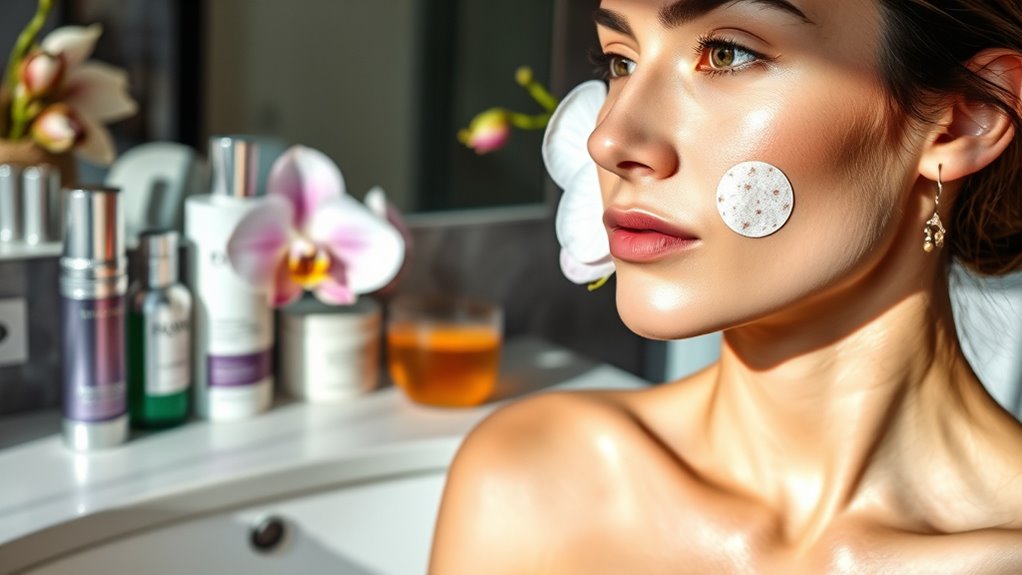
Choosing the right type of pimple patch is just the starting point; applying it correctly is key to maximizing its effectiveness.
First, clean your skin with a gentle, oil-free cleanser, then apply a toner to prep the area. Make certain your skin is completely dry before placing the patch, as moisture can weaken the adhesive properties of the patch.
Select a size that covers the pimple and some surrounding skin. Use clean hands or tweezers to handle the patch, pressing it flat for a few seconds to guarantee it sticks.
Aim to leave the patch on for at least six hours, preferably overnight, but don’t exceed 24 hours.
Integrating Pimple Patches Into Your Skincare Routine

Integrating pimple patches into your skincare routine can elevate your acne management game considerably. Start by cleansing your skin with a gentle cleanser before applying the patch. Opt for non-comedogenic and hypoallergenic products to minimize irritation. Remember, avoid applying serums or moisturizers directly under the patch to guarantee it adheres properly. It’s crucial to check that other products are compatible with the patch’s ingredients. Continue your regular skincare steps around the patch area, but don’t overlap treatments. Pimple patches can effectively manage breakouts, enhance healing, and prevent picking. Hydrocolloid patches absorb excess fluid, pus, and oil from pimples, further speeding up the healing process. Customize your choice of patches based on your skin type, like using salicylic acid for oily skin or tea tree oil for inflammation.
Makeup Considerations With Pimple Patches

When it comes to applying makeup over pimple patches, preparation is key for a flawless finish. Start by cleansing and drying your skin, then apply the pimple patch before your skincare routine. If you choose to use toner, make certain it’s completely dry before patching. Opt for patches that fully cover the blemish and guarantee they adhere firmly.
When applying makeup, use a light touch and avoid excessive foundation or concealer. A matte finish concealer works best to blend the patch, so select a shade that neutralizes its color. Additionally, applying makeup over a patch can create a smoother surface for easier application, enhancing the overall look. It’s also beneficial to ensure that your skin is well-hydrated, as proper aftercare can improve makeup application and overall skin health. Remember that maintaining digestive health through a balanced diet can also reflect positively on your skin’s appearance.
Remember to use a gentle dabbing motion, steering clear of vigorous rubbing. Avoid radiant finishes that can draw attention to the patch, keeping your look natural and seamless.
Post-Application Care for Your Skin

After removing your pimple patch, it’s crucial to care for your skin properly to support healing and maintain its health. Start with a gentle, non-comedogenic cleanser to remove any patch residue without stripping your skin’s natural defenses. Once cleaned, apply a hydrating moisturizer to prevent dryness. A calming toner can help restore your skin’s pH balance and soothe any irritation. Additionally, using a hydrocolloid patch can enhance the healing process by providing a protective barrier against bacteria. Pimple patches often contain salicylic acid to aid in reducing inflammation, making them a valuable part of your skincare routine. Remember, the use of essential oils can also provide additional soothing benefits when diluted properly, enhancing your post-application care. Furthermore, maintaining a clean air environment with an air purifier that utilizes HEPA filtration can reduce allergens and pollutants that may irritate your skin. Don’t forget sunscreen with at least SPF 30 to protect against UV rays, which can worsen post-acne marks. Avoid harsh products and exfoliants, as they can irritate your skin.
Preventative Measures to Avoid Breakouts
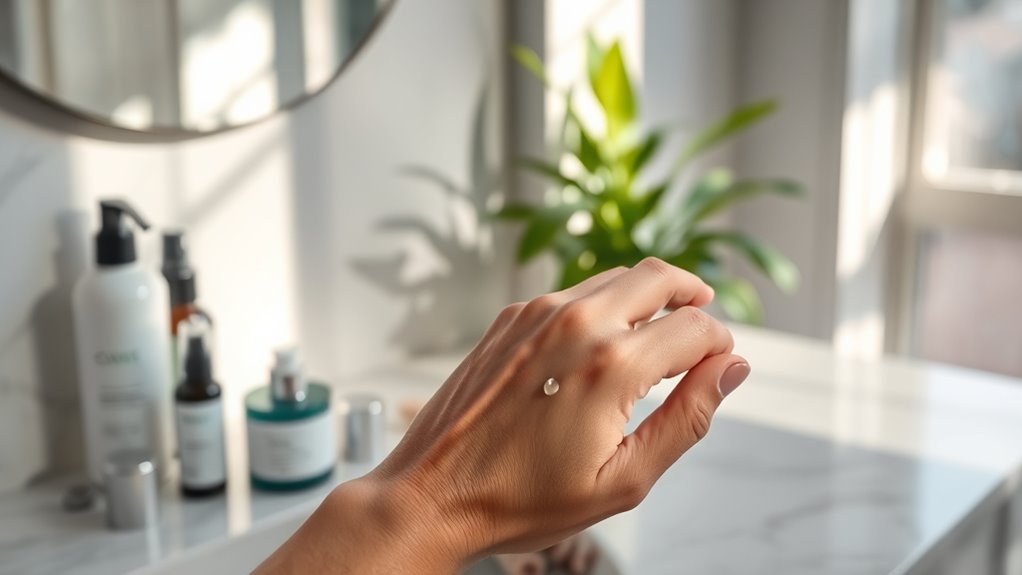
Maintaining healthy skin goes beyond post-application care; it involves taking proactive steps to prevent breakouts.
Start by keeping your face clean; wash it once or twice daily with a benzoyl peroxide cleanser. Avoid scrubbing—just use your hands and pat dry with a clean towel. Consistent gentle cleansing is essential for acne management, as it helps maintain skin balance and reduces the risk of irritation.
Control your diet by reducing sugar and carbohydrates, as they can trigger breakouts. It’s also beneficial to incorporate foods rich in antioxidants, which can support skin health and improve overall complexion. Pay attention to hair care; wash oily hair frequently and avoid irritating products.
Always wash your hands before touching your face to prevent bacteria transfer. Change your pillowcases regularly and use clean towels to minimize exposure to oils. Using hydrocolloid patches can also help protect blemishes and promote faster healing.
Finally, manage stress through relaxation techniques, as stress can worsen acne.
These simple measures can keep your skin clear and healthy.
Monitoring Skin Reactions After Use
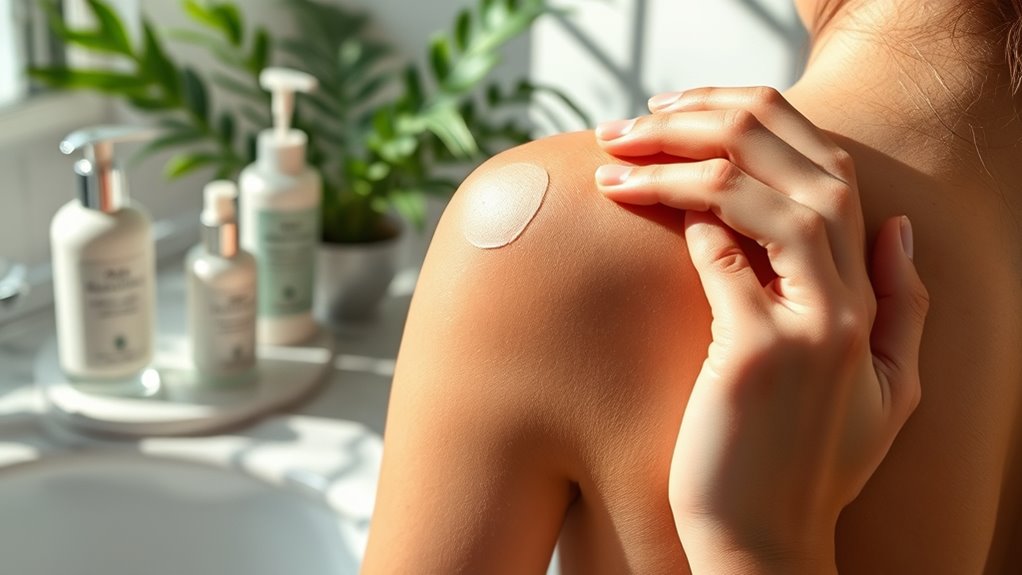
It’s crucial to keep an eye on how your skin reacts after using a pimple patch. You might notice common reactions like redness, itching, or dryness around the patch area, especially if it’s medicated. If you experience hives or tightness in your throat, stop using the patch immediately and seek medical help. To minimize irritation, choose hypoallergenic patches and keep your skin clean and dry before application. After removing the patch, gently cleanse the area and apply a mild moisturizer to soothe any irritation. It’s also important to note that pimple patches may cause skin irritation in some individuals. Avoid harsh products and direct sunlight to prevent further discomfort. If irritation persists, consult a dermatologist for guidance on managing your skin’s reactions effectively.
Combining Pimple Patches With Other Treatments

While combining pimple patches with other treatments can enhance your acne-fighting routine, it’s essential to approach it with caution.
Applying spot treatments directly under patches can lead to irritation or burns, especially with ingredients like benzoyl peroxide or salicylic acid. Always cleanse and dry your skin before patch application for best results. Spot treatments can be effective when used appropriately alongside pimple patches.
Stick to applying acne medications before placing a patch, but avoid using strong treatments right underneath. Choose the right patch based on your acne type—hydrocolloid for whiteheads and salicylic acid for blackheads.
Frequently Asked Questions
Can I Use Pimple Patches on Fungal Acne?
You can use pimple patches on fungal acne, but they’re not a primary treatment.
They might help reduce inflammation and prevent you from picking at the bumps. Make sure to apply them on clean, dry skin for better adhesion.
However, combine them with antifungal treatments for best results. Remember, pimple patches are more effective for surface-level pimples, so don’t rely solely on them for fungal acne management.
Are Pimple Patches Safe for Sensitive Skin?
Using pimple patches on sensitive skin can feel like walking a tightrope; one wrong step and you might fall into irritation.
While these patches can be effective, they may cause redness or dryness if your skin’s sensitive.
Opt for hypoallergenic options and always conduct a patch test first.
If you notice irritation, it’s best to consult a dermatologist to guarantee you’re treating your skin safely and effectively.
Keep your skin happy and healthy!
How Often Can I Use Pimple Patches?
You can use pimple patches as often as needed, depending on your skin’s response and the type of acne.
Hydrocolloid patches work well for surface pimples, while microneedle patches are better for deeper ones.
Change the patch every 24 hours or when it turns opaque. If you notice irritation, reduce wear time or frequency.
Always apply patches to clean, dry skin for the best results and maximum effectiveness.
Can Pimple Patches Be Reused?
No, you can’t reuse pimple patches.
They’re designed for single use, and reusing them can lead to bacterial infections and reduced effectiveness.
Once a patch has absorbed sebum and dirt, it’s done its job.
It’s best to discard it after 6 to 12 hours of wear.
For ideal hygiene and skincare results, always apply a fresh patch as needed to keep your skin healthy and clear.
Do Pimple Patches Expire?
Imagine peeling off a pimple patch only to find it’s lost its magic.
Do pimple patches expire? Yes, they do. Typically, they’ve a shelf life of three years, but once opened, their effectiveness can wane.
If you notice changes in color, texture, or even smell, toss them. Using expired patches could lead to irritation or infection.
Always check the expiration date and store them properly to keep your skin safe and glowing.
Conclusion
Incorporating pimple patches into your skincare routine can be a game-changer, like adding a secret weapon to your beauty arsenal. Just remember, while these little miracles work their magic, give your skin the TLC it deserves. Embrace the journey of healing, and watch those pesky blemishes fade away like clouds parting for the sun. With the right approach, you’ll not only conquer breakouts but also reveal the radiant, clear skin you’ve always dreamed of.





